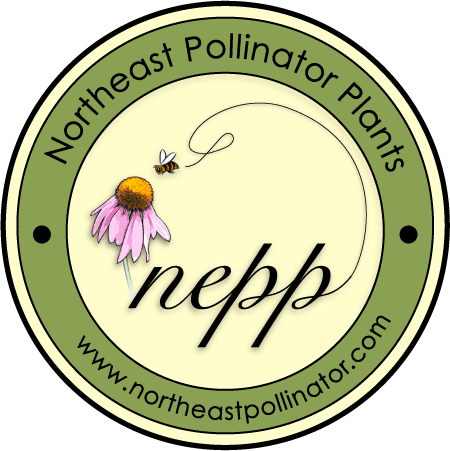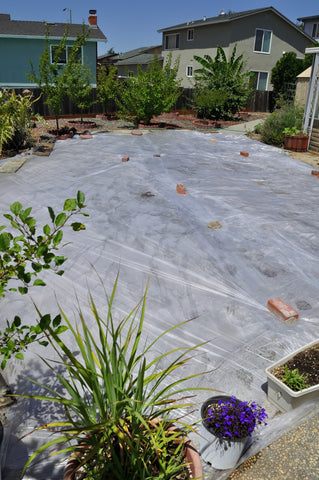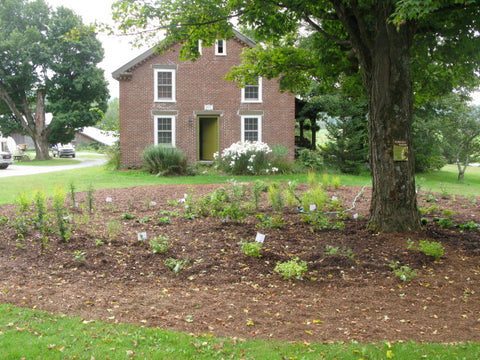Planting for Pollinators

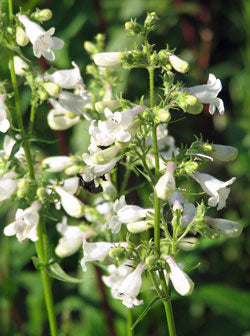
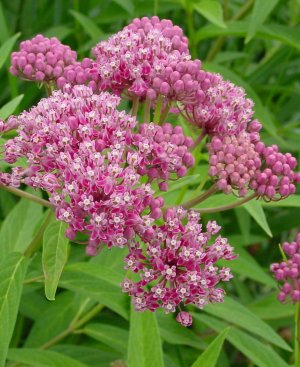
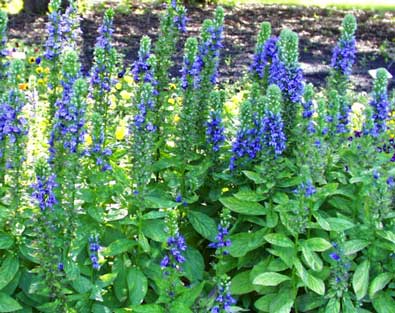
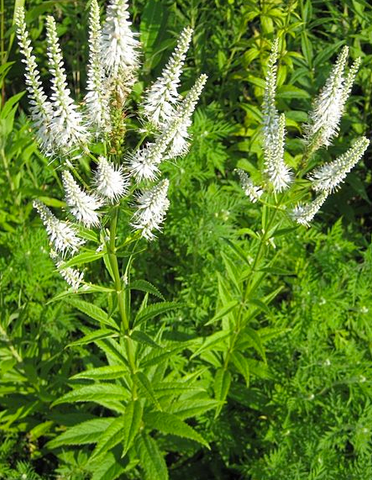
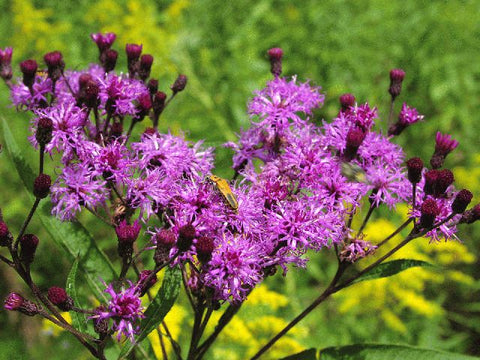
GUIDELINES FOR SELECTING PLANTS AND PLANTING A POLLINATOR GARDEN:
WHY NATIVE PERENNIALS?
Why do we sell native and naturalized perennials? Native wildflowers, particularly perennials, are perhaps the best source of pollen and nectar for pollinators, in both quantity and quality. Other growth forms, such as native trees, shrubs and vines, as well as many annuals and herbs, can be great additions to extend foraging options.
Selecting plants for pollinators is a rather specific task. The native pollinators of your area have a long evolutionary history tied closely with the native plants of your region and, understandably, have a preference for what they are used to, in some cases, they simply won't visit or can't digest most newcomer or exotic plants. Researchers such as Douglas Tallamy, author of Bringing Nature Home and Nature's Best Hope, see our Resources page, are finding that native insects NEED native plants, meaning plants native to your region.
We, at Northeast Pollinator Plants, include some long-term naturalized plants, plants that have been introduced to our region and have become established, only if they have proven to be non-invasive and are of significant value to pollinators.
Meanwhile, other researchers, like Annie White, a graduate of the University of Vermont, (who had a research plot on our farm, lucky us!) was trying to determine if cultivars of native plants, human-manipulated plant species that have, say double flowers, stronger colors or more compact growth, could be just as appealing to the local insects. Cultivars are generally identified in single quotations after the species name such as Echinacea purpurea 'Magnus', 'Magnus' being a cultivar of the native purple coneflower. It sounds like there MAY be some cultivars that will satisfy the pollinators, but mostly they would rather you stuck to those true native plants.
I say, hey, we humans can adjust OUR aesthetic, and learn to love the maybe less showy true native plants and, in exchange, enjoy the incredible dance of the native pollinators and the satisfaction in knowing we are keeping our landscape ALIVE!!
Ideally, you would be selecting native wildflowers from seeds collected from a nearby source. We, at Northeast Pollinator Plants, are getting there, each year increasing our production from seeds that have been wild collected from our region.
If you are a willing seed-collector of species we are offering, and in the New England and New York states region, please let me know!! We have developed a website to encourage wild seed collectors, please take a look:
https://northeastwildseedcollectors.com/
But how about the non-native, and oh so valuable, honeybees and their beekeepers? The pollinator plants offered here will be big hits with the honeybees, while attracting more native bees will make them more efficient foragers.





SIZING YOUR GARDEN AND SELECTING PLANTS:
An ideal pollinator garden should offer constant and overlapping flowering of native wildflowers from early spring to late fall. To do this, Xerces Society suggests selecting:
At least 9 species of wildflowers with 3 early-flowering, 3 mid-flowering and 3 late-flowering, offering a variety of flower colors, shapes and sizes to appeal to a diversity of native pollinators AND,
Add at least 1 native grass for nesting sites and material, AND
Plant in swaths of 8 of each species for more efficient foraging.
Using these guidelines, we have created several Pollinator Garden mixes for varying sun/shade and soil conditions. Selecting the quantity four (4) of a garden collection, which includes 21 plants, for a total of 84 plants, will get you closest to the guideline, giving you 8 plants each of 10 flowering species plus 4 plants of 1 native grass species. You may also make your own collection or enhance your existing garden by selecting from the list of individual plant species.
Every little bit can help! Don't fret if you don't have the space or budget for meeting the guidelines suggested above, but plant what you can and know you are part of the solution.
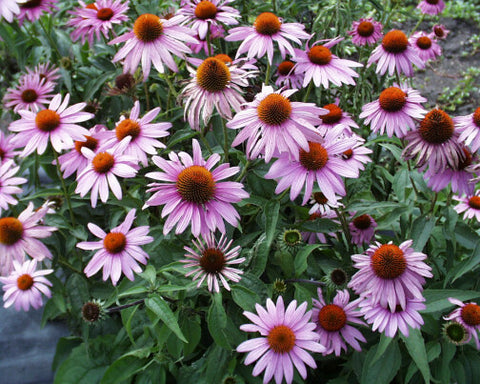


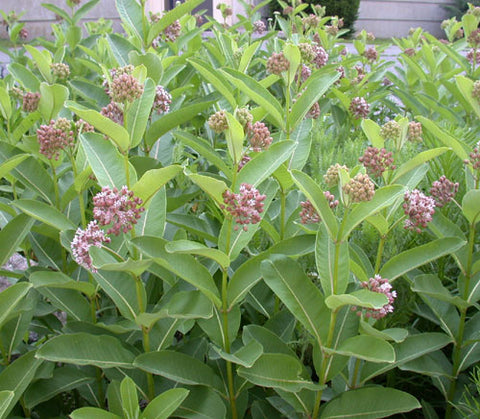
"GARDEN" PLANTS OR "NATURALIZING" PLANTS:
You may have noticed already, we describe our plants in the Uses description as either "Garden" plants or "Naturalizing" plants".
"Garden" plants tend to be well-behaved and long-lasting and generally should be just fine in a garden setting. A note of caution though, these ARE wild flowers, so the Garden category is a relative term. You will find that some that are called Garden plants will still do a bit of reseeding and require a tad bit of weeding out each year. While others, like Echinacea purpurea, the beloved purple coneflower, can be frustratingly short-lived, but such a sweet plant we keep it in the Garden plants category.
"Naturalizing" plants, on the other hand, are ones that are more at the other end of the spectrum, being more short-lived but rather rambunctious in reseeding or spreading through rhizomatic roots, or both. These plants are more suited to a cottage garden or meadow situation, where the gardener allows the plants to spread and reseed as they please, with some gentle editing to keep the more aggressive spreaders from taking more "turf" than their fair share.
The following spreadsheets show the plants offered on Northeast Pollinator Plants as two sheets, Garden plants and Naturalizing plants, with their flowering time and color, which can help you select plants to ensure that you are providing a diversity of flower colors and constant and overlapping flowering times.


I know, the quality of these really important sheets, is not great. If you would like to have the pollinator plant palette emailed to you, please email with your request. See Contact Us below.




SUN-PART/SHADE-PART and DRY-MOIST/MOIST-WET, HOW TO JUDGE:
If your garden receives 4 or more hours of direct sun, it's safe for plants in the sun/part sun category. If less than 4 hours of direct sun, select plants in the shade/part shade category.
The dry-moist/moist-wet refers to the texture, or size of the particles, of the soil in your garden. Sandy soils have larger particles and tend to be dry while clay soils have tiny particles and tend to hold water longer and are often wet. Loamy soils are in the middle.
To test your soil, grab a small handful and squeeze it to form a ball in your hand. If the soil ball doesn't really hold together when you open your hand, you likely have pretty sandy, dry soils. If the ball holds together, try squeezing the soil out of your hand between your thumb and forefinger to form a ribbon. If you can easily form a ribbon, you likely have clay, wet soils. If the ribbon starts to form but breaks off quickly upon forming, it is likely loamy soil which gives you the most flexibility and can select plants rated for dry-moist or moist-wet soils.

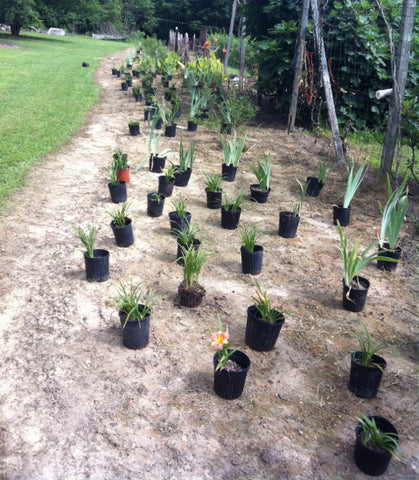

PLANNING YOUR GARDEN:
It's a good idea to plan out your garden before you start planting. You can start by drawing out your plan or simply placing the pots on the prepared bed. We suggest laying out the wildflowers and native grasses about 2' apart, which would be 4 s.f. per plant. Multiply the number of plants you have by 4 and that's how much square foot space you should allow for your pollinator garden.
If you are planting a garden with ground covers plants, plant these plants in between your other pollinator plants/wildflowers that are at 2' apart; so that the whole garden is planted essentially with plants 1' apart. See the diagram here with o's for the pollinator plants/wildflowers and x's for the ground covers and g for the native grass.

It can be nice to arrange the plants in swaths of single species for a less chaotic look for us humans and for more efficient foraging for the pollinators, who tend to stick to one species at a time, before moving on to the next. Be sure to create places for you, the humans, to sit and observe the pollinators in action.
Also, you may want to consider pathways in your garden to allow wandering about to observe pollinators in action and to allow maintenance without stepping on your plants. Many of the native wildflowers can get pretty big, so leave at least 6'-8' between plants where you would like the path.


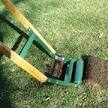

PREPARING YOUR PLANTING AREA:
The main goal when clearing an area to be planted to perennials is to turn the soil as little as possible, to avoid bringing weed seeds to the surface.
IF THE AREA IS CURRENTLY LAWN...
Bravo!! Replacing lawn with habitat is a win-win. Lawn provides little to no habitat while, according to the EPA, on average, mowing for one hour pollutes as much as driving your car 100 miles. For most folks, that translates your weekend mowing into polluting as much as your weekly commute! My motto: "Lawn only where you REALLY need it!"
Anyway, there are a couple ways to get rid of that lawn. The easiest and quickest, is to rent a sod-cutter and dump that nasty lawn in the compost pile. If you're truly industrious you can do this by hand with a spade or hand sod-cutter. If you're more patient than me, you can also rid yourself of the lawn by "sheet mulching" or "solarization"; this will require many months to a year. Web-search those words for plenty of tips on how to do that.
Once the soil is bare, you don't really want to amend the soil much as wildflowers are happiest in the more barren soils of the wild.
IF THE AREA IS CURRENTLY A GARDEN...
If the garden is weed-free, you're ready to plant. Amended soils, in other words, enriched with fertilizers and/or years of compost layering, can sometimes be too rich for wildflowers which tend to be happier in, as stated above, the more barren soils of the wild. Not much you can do to reduce the nutrient level, but let time take its course. Some of the wildflowers may stretch a bit the first couple years. I'll admit, I do tend to add a tiny bit of peat or compost in each planting hole, maybe just out of habit, but feel like it does help hold the moisture while the small plant is getting established.
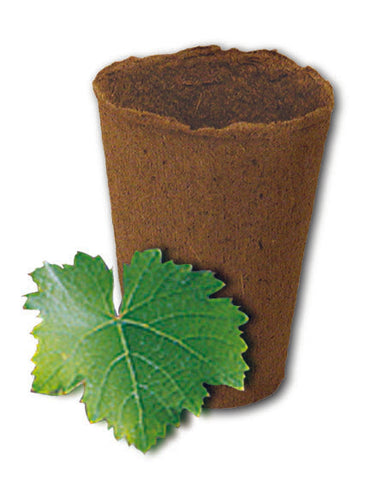
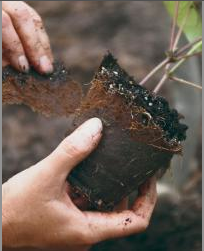


PLANTING THE PLANTS:
We grow our plants in biodegradable pots which can be planted directly in the ground. There's no reason to remove the pot from the plant and a good idea not to disturb the roots anymore than you need to. You should, however, push down or peel off the very top edge of the pot to the level of the potting mix, so that the pot won't stick above the ground when you plant. If it did, it could wick dry and cause the plant to dry out too fast.
Plants in biodegradable pots tend to dry out more quickly than in plastic pots so be sure to keep your babies moist while they are waiting to get planted. Before laying out your plants, water them to near saturation and don't let them sit out too long in the hot sun or breeze to dry out.
Once you've got your garden planted, mulching is a choice. The majority of native bees are ground-nesting. Mulch is definitely a deterrent for nesting. If you're planting a garden with ground covers, no need to add mulch; but you should hoe your garden weekly for the first season and maybe a bit the next year, depending on when you planted, to reduce weed pressure while the ground cover is taking hold. (My favorite pollinator ground covers are Viola sororias, Common Violet, Prunella vulgaris, Self-Heal, and Fragaria virginiana, Wild Strawberry). if you do mulch your garden and don't have much bare sandy soil around, consider adding a designated bee-nesting-sand-box (18" deep) and make sure you label it clearly. Bee nesting and children's sand boxes are not a pleasant mix.
Keep your newly planted garden watered every day for at least the next two weeks, until those little roots are well established and out there doing the work of seeking out water and nutrients.
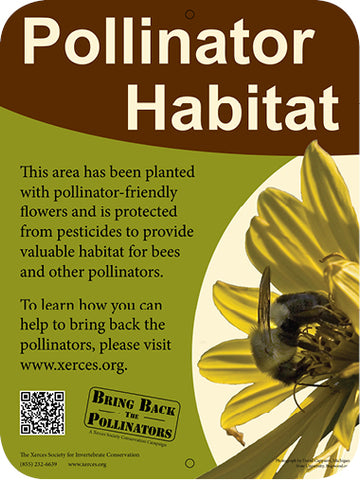
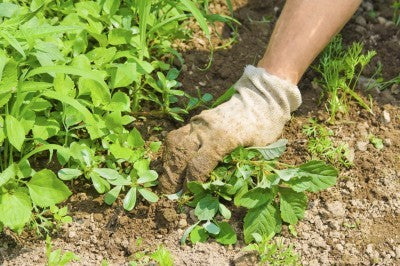
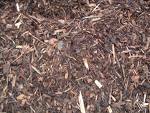

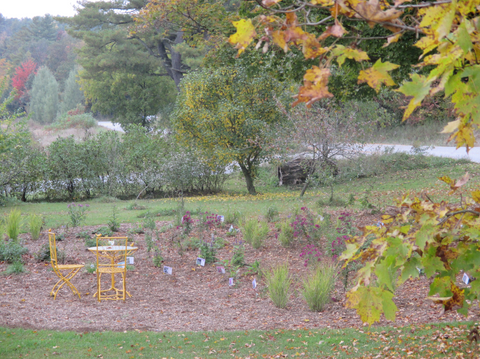
MAINTAINING YOUR POLLINATOR GARDEN:
First off, let your neighbors and visitors know you have planted a pollinator garden. A great way is to put up a "Pollinator Habitat" sign available from Xerces Society. http://www.xerces.org/pollinatorhabitatsign/ How about being counted and registering your garden with the Million Pollinator Gardens Challenge. http://millionpollinatorgardens.org/
Your new pollinator garden will need a moderate amount of attention, particularly the first couple years after planting to keep down the weeds while the plants claim their space and to keep in check the bit of reseeding to which some of the species may be prone. If you have mulched your garden, you will likely need to put a fresh layer of mulch the first couple years, until the plants have truly filled in.
A tradition of many gardeners is to "clean up" their perennials in the fall. Some argue this is important to reduce disease issues. Well, sure, if you have a disease issue, that plant should be cut back. BUT, in general, there really is no need to cut back your perennials. The seed heads are valuable wildlife food and the stems and leaf litter are important nesting and overwintering sites for all kinds of critters including many pollinators. If you simply must "clean up" your pollinator garden, (this is your aesthetic, not the bee's, and simply is not necessary), wait until spring, after there have been at least 5 days of day-time temperatures above 50 degrees F. This should allow ample time for any overwintering creatures to have moved on with their lives.
On a related note, leave the leaves, and this is not just in your pollinator garden. As the leaves break down, they are a natural mulch and very important natural fertilizer. In general, they will blow and gather where they can be of most use, under your shrubs and perennials. You can certainly rake up and deposit them where they need to be, if the wind is not aiming where you want them. If you have simply more leaves than you can use, and you have room, try creating a leaf compost area, or donate your leaves to a friend of neighbor who is not rich in this amazing resource.
There should be no need to add any fertilizers (other than the leaves just discussed) and definitely NO pesticides for your pollinator garden. The latter is such an important topic, we'll create a separate heading for it...
PESTICIDES IN YOUR LANDSCAPE:
While it should be clear you do not want pesticides applied in your pollinator garden, it is important to minimize the use of pesticides in your landscape. As farmers, we understand that some crops simply cannot be grown without pesticides. But there is the decision on whether to even grow that crop and some choices on what pesticides, cultural or biological agents you can employ, to reduce the pest issue while causing the least amount of harm to non-targeted species. We each have a responsibility to choose our crops and plants in our landscapes that minimize the need for harmful maintenance.
Neonicotinoids are a class of pesticides that was introduced in the 1980s and have become immensely pervasive in the agriculture, horticulture and landscape maintenance industries. These pesticides are systemic meaning once applied they pervade the entire plant and are expressed in all parts including the pollen.
Many nurseries have made a commitment to not selling plants that have been treated with neonicotinoids, due to their proven harm to pollinators, especially bees. When purchasing plants, ask your nursery or garden center if the plants have been treated with neonicotinoids. It can be a challenge for growers to access plants that have NOT have neonicotinoids applied; really, these pesticides are that pervasive. Your asking and not purchasing plants that have been treated with neonicotinoids is a step in activism to protect our pollinators.
ENJOY AND SEND US PICTURES!
plants@northeastpollinator.com
